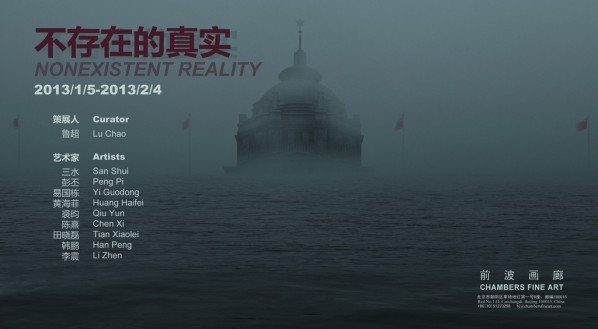
With the New Year approaching, Chambers Fine Art Beijing is pleased to announce the opening of a young artists’ group show Nonexistent Reality on January 5, 2013. Starting from Midwinter 2009 to 2010, and Make It New in early spring 2011, to Nonexistent Reality this time around, these young artists’ group shows in our program exemplifies that Chambers has been increasingly focusing on younger artists, in addition to our consistent emphasis on established and mid-career artists.
The title Nonexistent Reality originates from The Truman Show, a dark comedy film. The film depicts a preposterous fable of life: the tragic character Truman is deceived and fooled all his life, living in a virtual world surveilled under numerous cameras. The film reflects multiple social issues such as human rights, freedom and privacy. Yet what is most impactful is the human desire for truth and freedom. In the ending, the ultimate puppeteer behind the scheme tells Truman that he has become the most popular star in the world, if he stays in this fictional world he can carry on his star life. Truman is however unconvinced and chooses to leave. Everybody has a different definition for the concept of truth. On a surface level, only what is visible to the naked eye can be regarded as real. But this reality is not singular. There is another reality deep inside our hearts. It is only peripheral to our vision but this reality holds great spiritual significance. The exhibition introduces the realities that are beyond human vision to our spiritual world, hoping to bring the viewer a unique otherworldly and “illusory” sensation.
[gallery link="file" orderby="title"]
The exhibition encompasses painting, sculpture, photography, video and other forms of expression. Nine young artists, San Shui, Peng Pi, Yi Guodong, Huang Haifei, Qiu Yun, Tian Xiaolei, Chen Xi, Han Peng and Li Zhen attempt to explicate the concept of “nonexistent reality” through four independent themes: Mirage, Butterfly Dream, Virtual World and Fairytale. The nine artists in the exhibition all have their own idiosyncratic forms of expression and conceptualization. San Shui’s (b. 1972) Bund series revolves around the architectural landscape and the human living experience. The foggy sea and landmarks on the Bund in Shanghai compose a poignant and mirage-like scene. Peng Pi (b. 1984) has chosen Vietnamese Huali wood as his canvas. Using a magnifier to focus light, he left burn marks resembling fossils of fish that no longer exists, transplanting past lives onto the Huali wood that is full of life, as a metaphor for rebirth. Yi Guodong (b. 1981) imagines war scenes from the future in a game-like manner. The playful tension between the war on the surface and the anti-war philosophy from Mo Gong exemplifies the artist’s sensitive imagination and rational contemplation on our current reality. Huang Haifei (b. 1983) breaks the rules by using the stamps that are important for purposes of authenticating name and status in traditional Chinese paintings to create fluid, lively and dream-like images. Underneath Qiu Yun’s (b. 1988) brushstrokes hides a girl’s sensitive dreamscape. Mystery, sweetness, danger and bizarreness are all parallel, inviting the viewer to the fascinating dream space. Tian Xiaolei (b. 1982) creates unique images by ways of digital modeling, depicting a group of white-collar workers running out of the subway after work towards the carnival island. The artist’s approach in pairing the imagery alluding to the spectacular and orderly National Day parade and the thrillingly wild fun at the amusement park “Happy Valley” is highly farcical and satirical. His utopian island seems to suggest that in this world of desire, the carnival island becomes the shelter and paradise, as well as the destination for the last indulgent rave party before the end of the world. Chen Xi (b. 1985) uses ink pens and watercolor to compose many fictional characters and stories. He explores in depth the humorous and weird characteristics of these fictive identities. For him, the nonsensical humor in the images is a true reflection of his inner world. Han Peng (b. 1982) makes use of many quotidian objects from our childhood and pointedly recreates a heartwarming scene for grown-ups – a fairytale in which a naïve little tin man leads an army of little objects to fight against the adult world. Li Zhen’s (b. 1989) work carries a toxic beauty and this beauty signifies very different things depending on the audience – “the most beautiful fairytale is not for children, because children themselves live in a fairytale, only adults, no longer possessing fairytale in their hearts, will be touched by fairytales.” The beautiful visual form of Li Zhen’s work is enhanced by its ironic humor.
In recent years, a growing number of art organizations start to focus more on the new forces of young artists, not only because young artists carry more vitality, but also for that the younger generation embodies the future direction of contemporary Chinese art. Our exhibition dates coincide with “slight cold” and “the beginning of spring” in the lunar calendar. We hope this shall be a good omen for next year’s artistic climate as spring arrives.
About the exhibition
Duration: January 5 — February 4, 2013
Opening Reception: Saturday, January 5, 2013, 3 - 6 pm
Venue: Chambers Fine Art Beijing
Address: Red No.1-D, Caochangdi, Chaoyang District, Beijing, 100015, China
For more information, please contact the gallery at + 86 (10) 51273298 or bj@chambersfineart.com.




























